Privilege Escalation: What is it and Why is it so Important?
Bulletproof Backups for Your WordPress Website
Fortify your business continuity with foolproof WordPress backups. No data loss, no downtime — just secure, seamless operation.
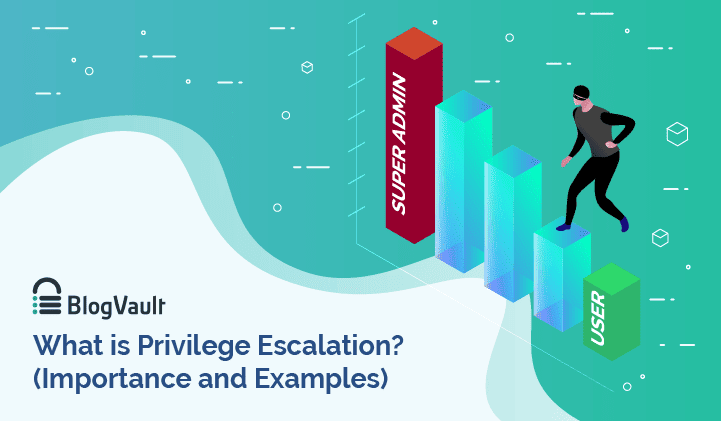
Do you have multiple users on your WordPress website? Did you know hackers can exploit user accounts to take full control of your website? They can do this by taking advantage of what is known as a privilege escalation vulnerability.
These vulnerabilities appear in some WordPress plugins and themes from time to time. By exploiting the vulnerability present, they’ll try to break into any normal user’s account. From there, they escalate the permissions of that account and gain admin access to your website.
If they’re successful, we can only imagine what havoc they’ll wreak on your site! All we can tell you that hackers cause irreparable damage to your site, your business, and your reputation. It can also be extremely expensive to fix the hack and recover your site.
Luckily, there are ways to prevent the privilege escalation hack! Here, we’re delving deeper into how privilege escalations take place and the impact it can have on your site. We’ll also show you how to fix such a hack and prevent privilege escalations on your WordPress website.
TL;DR – If your website is hacked, you need to fix it immediately. To avoid the hassle and long turnaround times to get your site cleaned, we recommend installing the WordPress Security Plugin on your site. You can scan and clean your site within a few minutes. The plugin will ensure that your website is malware-free and protected from hackers in the future.
[lwptoc skipHeadingLevel=”h3,h4,h5,h6″]
What Is Privilege Escalation?
WordPress has a feature that enables an admin to authorize other users to make changes to the website. But you may not want to give every user complete control to change anything they want. This is where user roles come in.
There are six different user roles available – subscribers, contributors, authors, editors, admins, and super admins. Here, subscribers have the least permissions while super admins can make changes to absolutely anything on the website.

It’s advisable not to grant every user administrator privileges but to make use of these limited user roles for network security reasons.
For instance, if a hacker gained unauthorized access to an author’s account, they can only edit, publish and delete their own posts. They cannot tamper with anything else.
But if there is a privilege escalation vulnerability, the hacker can exploit it to override these limitations. From here, they start bypassing user account control. So from having only author permissions, they can start gaining access to features that only a local administrator is supposed to have.
If this happens, there’s no telling what data the hackers can steal and what malicious activity they can carry out under your name!
To give you a clear picture of how this escalation occurs, we’ve explained it step-by-step below.
If you want to know more about user roles and the different permissions granted, learn more here.
How Does Privilege Escalation Work?
Privilege escalation is a type of hack that occurs in a series of other hacking activities. To explain how a privilege escalation attack happens, we’ll illustrate it with an example.
Step 1: Break-into Any User Account Of A WordPress Website
Let’s say, you run a website in which 10 users. Some are contributors and authors who can publish posts and some are privilege users with admin permissions who have elevated access and can control the whole website.
Say a contributor account is using a weak password that is ‘password123’. This is easy for the hacker to guess. Using another type of hacking method called brute force attack, the hacker tries different passwords to login to the account. (They can try hundreds of passwords in just a second). Because the password is so easy, the hacker is successful and now has contributor access.
But a contributor has low privileges. They can only write and manage their own posts but cannot publish them. So the hacker can’t do much with this account. They would want to elevate privileges to admin access because it will give them full control of the site.
To do this, the hacker needs to escalate privileges. Let’s see how that happens.
Step 2: Escalate Privileges By Overriding Limitations
Every WordPress site has plugins and themes installed. Themes and plugins enhance the design and layout, improve functionality and make the website stand out.
Sometimes, security flaws creep into plugins and themes. This means in the coding of the software, there is a weakness that hackers can exploit. So if you have the plugin or theme installed on your site and it has a vulnerability, hackers can use it to their advantage.
One such vulnerability can enable the hacker to escalate the privileges of a user’s account.
So coming back to our example, the hacker has already gained privileges to a contributor account. Next, using a vulnerability in a plugin, they are able to override the set permissions or get more privileges granted to this account.
Here, we need to know two types of privilege escalations:
Horizontal privilege escalation – In this case, hackers will be unable to rise to the level of admin. Instead, they remain on the same privilege level (such as contributors). However, they will be able to override permission levels. This will enable them to access data or functionality of the site that is otherwise not permitted to this user.
Vertical privilege escalation – This type of privilege escalation technique carries more potential danger. Here, the hacker starts off at a base account and is able to get more access granted to this account. This way, they are able to make the contributor account more powerful and get admin controls.
Step 3: Run The Attack
Privilege escalation is used in preparation for more specific attacks or a much bigger one. Once the hacker gains access to an admin account or is able to access data that they want, they can begin to carry out their real purpose. Some of the common malicious activities these miscreants carry out are:
- Stealing your business’ private and sensitive data.
- Stealing customer or client data and information that they can then sell for money or use to perform more hacks.
- And stealing more credentials of other valid accounts on your site.
- Erasing data and content on your website.
- Defacing your website and replace it with their own propaganda or promotions.
- Sending spam emails and messages to your customers.
- Displaying spam content and advertisements on your site.
- Executing malware on your site to sell illegal drugs or products.
- Hiding malware on your site to dupe visitors into downloading it.
- Redirecting your visitors to other websites such as adult sites or spam sites.
- Using your website to launch larger (DDoS) attacks to take down big brand websites.
So by understanding privilege escalation attacks, you can see that it is not the main attack. But it’s a huge contributor that enables the main hack to take place.
Assigning user roles isn’t enough to protect yourself from being hacked. Secure your site with a reliable security plugin like MalCare. Click To Tweet
Impact Of Privilege Escalation
Privilege escalation, while only a part of a larger attack, can spell disaster for your WordPress website.
1. Slows Down Your Website
Your web host provides you with limited resources for your website to function. To run malicious activities, hackers will use attack techniques that eat up your website’s resources and load your server. This will slow down your website and bring down its performance. In this day and age, speed is extremely important. With a slow website, you can be sure your visitors will bounce to competitor sites.
2. Webhost Suspension
If your site is hacked and you don’t realize it, you can be sure your web host will realize it. If your website uses more web server resources than it’s allotted, it could cause problems for the hosting company and slow down other websites that they host. So if they find malware on your website, your web host will suspend your account immediately and take your website offline. You would need to clean your site and then contact them to get your site back online.
3. Google Blacklist
Google will blacklist your website and so will other search engines. The search engine cares about its users and their experience is given the utmost importance. If Google detects malware on your site, it will blacklist it and display a warning that doesn’t allow visitors to come to your website.
4. Data Breach
In this type of cyber attack, if the hacker gains unauthorized access (without access tokens) to confidential business data, or even personal data of investors, clients, and customers, it is considered a data breach. This could spell a whole world of trouble. In most cases, you have to report it to relevant authorities. Report the hack to your web hosting provider and your local cybercrime police. You need to research your individual country or state laws to find out the procedure for reporting the crime.
5. Silent Data Theft
Attackers know how to cover up their tracks. They could come in as a system administrator, steal data, and then delete activity logs and any traces of their presence. Therefore, you might not even be aware that a hack has taken place. Meanwhile, your private information is being sold and published around the world.
6. Loss of Traffic and Sales
If you face the consequences mentioned above, you will definitely lose out on traffic coming to your website. This means you lose sales and your business will drop.
7. Loss of Customers’ Trust
When your website is hacked, especially if data is stolen, customers and visitors of your website will lose their trust in you. This is because you failed to take precautions to make sure this doesn’t occur. Getting back this trust is extremely hard.
So as a website owner, you need to take extra precautions against this happening on your website.
Fix And Prevent Privilege Escalation Attacks
Privilege escalation attacks are one of the most menacing hacks WordPress website owners can face. Luckily, it can be fixed and prevented as well. If you’ve been hacked already, we’ll take you through the steps you need to take to fix the hack. After that, we’ll show you how to stay safe and prevent such vulnerabilities on your website.
There are different ways to fix a hacked website, but we recommend a WordPress security plugin right off the bat because this kind of hack is tricky to detect. A hacker could’ve attacked multiple users’ accounts and have access to various parts of your website.
They could’ve injected their malicious code into different parts of your website. Trying to find and fix the hack manually is simply not feasible nor will it be effective.
Here, we’ll show you how to clean your website using an effective and reliable plugin – MalCare.
Step 1: Set Up MalCare On Your Site
First, install MalCare on your website. When you activate the plugin, it will scan every file and folder of your website. It analyses your entire site and user behavior, and will determine every place the hacker has injected malware. Once it detects the malware, you’ll receive an alert like so on the MalCare dashboard:
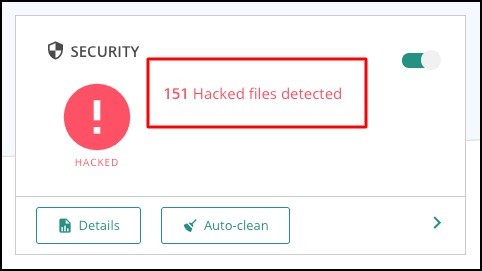
Step 2: Auto-clean Your Site
Next, you need to click on the auto-clean button. The plugin will automatically begin the cleaning process. This will take just a few minutes. We must mention that this is a big plug as the incident response time is reduced to just a few minutes. The detection and response is extremely quick making MalCare the fastest Malware Removal plugin on the market.
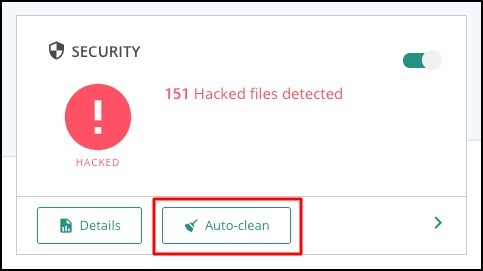
We recommend running a second scan just to double-check that your site is clean before we proceed with the next steps. In case you face any issues during this process, you can contact the MalCare security team that’s available 24×7.
If your WordPress site is hacked and you want a clean-up solution that actually works, try the MalCare plugin. You can clean your site in under a few minutes. Click To Tweet
Step 3: Update Your Website
When vulnerabilities are found in plugins and themes, they are usually patched promptly. The developers of these plugins/themes release updated versions of their software.
You need to update the plugins and themes on your end to ensure your running on a version that is secure.
To do this, from the MalCare dashboard, you can see the updates available for three elements of your site – your WordPress core installation, themes, and plugins.

You can roll out all updates on your website at once. We recommended reading How to Safely Update Your WordPress Site.
Recommendation: Check online for known vulnerabilities in plugins and themes. If you find that the ones you use on your WordPress site have vulnerabilities, you need to update it immediately. Sometimes, you may not find an updated version available or that the last update was years ago. This can happen because sometimes creators of these plugins/themes abandon their software because they can’t maintain it. If you cannot find an update for your plugin/theme, it’s best to delete it.
Step 4: Delete Unused Themes And Plugins
It’s common among WordPress site owners to install plugins and themes and forget about them. But every added application on your website gives hackers more opportunities to hack in.
We recommend going through the list of themes and plugins you have installed on your site, even if they aren’t activated. Delete the ones you don’t use.
You can delete the plugins/themes directly from the MalCare dashboard as well.
Step 5: Prevent Future Attacks By Hardening Your Website
WordPress.org recommends that you implement certain security measures on your website to make it strong against privilege escalation attacks and other hacks.
What’s good to note here is that hackers like to target sites that are easy to hack into. This means if you have the basic web security measures on your site, there are high chances that the hacker will move on to an easier target.
Here, we’ll list out the hardening measures you can implement with MalCare. But we also recommend that you read our extensive guide on WordPress Hardening.
Note: You might’ve seen with banking applications or internet banking, you can only make three login attempts, after which you need to choose the ‘forgot password’ option or contact the system administrator. This is to limit the number of times a hacker can try to guess your password. If you’ve installed MalCare, your site is already protected with a firewall and limited login protection.
Once you clean your website with MalCare, you will see the following option:
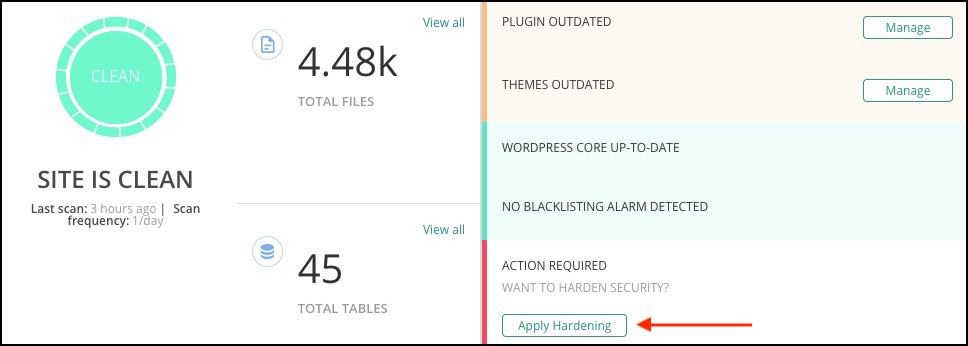
By clicking on ‘Apply Hardening’, you’ll be directed to the next page. Here, you can implement hardening on three different levels depending on the needs of your site.
1. Essentials

If your website was hacked, you should carry out these two measures immediately. Changing security keys will ensure any passwords stored in browsers are invalid. Next, you can change the passwords for all users on your website.
We also recommend you ensure all users create strong usernames and passwords. It’s best to use a passphrase in combination with numerals and symbols like so:

2. Advanced
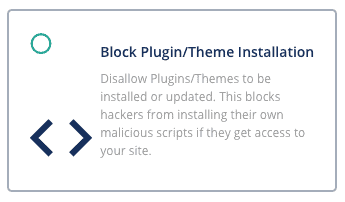
This will ensure none of the regular users on your WordPress site can install a theme or plugin. This will prevent hackers from installing their own malware on your site. When you need to install a theme or plugin, you can enable it by deselecting this option.
3. Paranoid:

These two measures will ensure hackers can’t insert any codes into your site that will execute commands.

Apart from hardening your WordPress website, you should also run a penetration test on a regular basis. This will test how far a hacker can go given the security measures you’ve implemented on your WordPress site. It should also check the security of your system or application as well.
And always follow the principle of least privilege. Do not allow the user to have more access than they require. This can greatly reduce the chances of getting hacked.
Note: MalCare takes care of both WordPress files and database security. If you choose to use any other security plugin, ensure it secures both files and database access controls.
In Conclusion: Staying Safe Against Privilege Escalation Attacks
WordPress is one of the safest platforms to use to create and run your website. But owing to its popularity, it’s also an attractive target for hackers.
Hackers find different ways into WordPress sites but one of the most common attacks happens through plugins and themes that have vulnerabilities.
To stay safe from privilege escalation hacks and any other kind of hack as well, it’s best to first, keep your website updated always. And second, use a plugin like MalCare that will protect you against security threats and attacks, alert you if ever there’s a hack, and enable you to clean up your site instantly.
Try our MalCare Security Plugin Now!
Tags:
Share it:
You may also like

How to Limit Form Submissions with Droip in WordPress
Forms are an indispensable part of any website because of their versatility, letting you collect information for various purposes! However, people with ill intentions often attempt to exploit these forms…

How To Manage Multiple WordPress sites
Management tools help agencies become well-oiled machines. Each task is completed with the least amount of effort and highest rate of accuracy. For people managing multiple WordPress sites, the daily…

PHP 8.3 Support Added to Staging Feature
We’ve introduced PHP version 8.3 to our staging sites. Test out new features, code changes, and updates on the latest PHP version without affecting your live website. Update PHP confidently…
How do you update and backup your website?
Creating Backup and Updating website can be time consuming and error-prone. BlogVault will save you hours everyday while providing you complete peace of mind.

Updating Everything Manually?
But it’s too time consuming, complicated and stops you from achieving your full potential. You don’t want to put your business at risk with inefficient management.

Backup Your WordPress Site
Install the plugin on your website, let it sync and you’re done. Get automated, scheduled backups for your critical site data, and make sure your website never experiences downtime again.




